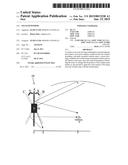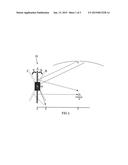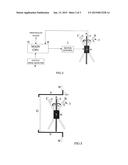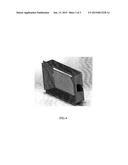Patent application title: STEALTH WINDOW
Inventors:
Ronen Meir (Ashkelon, IL)
Assignees:
ELTICS LTD
IPC8 Class: AF41H300FI
USPC Class:
49 25
Class name: Movable or removable closures radiant energy control
Publication date: 2015-01-15
Patent application number: 20150013228
Abstract:
A window in an asset, having stealth plates mounted adjacent the window,
in an active adaptive stealth system, the window including a pivotally
mounted window pane, a motor drivingly coupled to the window pane causing
the window pane to tilt relative to the asset, and a tilt control
mechanism controlling the motor to change the tilt position of the window
pane relative to the ground to approach a best match of IR image from the
window pane with the stealth plates.Claims:
1. A window in an asset, having stealth plates mounted adjacent the
window, in an active adaptive stealth system, the window comprising: a
pivotally mounted window pane; a motor drivingly coupled to said window
pane causing said window pane to tilt relative to the asset; and a tilt
control mechanism controlling the motor to change the tilt position of
the window pane relative to the ground to approach a best match of IR
signature from the window pane with the stealth plates.
2. The window according to claim 1, further comprising: an enclosure; said window pane pivotally mounted in said enclosure; and a fixed window pane mounted in said enclosure inside said pivotally mounted window pane to prevent escape of radiation from inside the asset via the edges between the pivotally mounted window pane in a tilt position and the enclosure.
3. The window according to claim 1, further comprising: a motor control circuit coupled to said motor; and a CPU processor of the active adaptive stealth system controllingly coupled to said motor control circuit, said processor receiving data of IR signatures of the stealth plates adjacent the window and activating said motor to tilt said window according to said received data.
4. The window according to claim 3, further comprising an angle sensor coupled to said CPU providing information of the asset angle to said CPU; and wherein said CPU actuates said motor to maintain a tilt position of the window pane at a fixed angle to the ground, regardless of the asset angle.
5. The window according to claim 3, wherein said window pane is mounted on a device providing pan and/or tilt of the window controlled by said CPU.
6. The window according to claim 3, further comprising: a thermal sensor coupled to said window pane to detect thermal radiation at a selected angle to the window pane, said thermal sensor coupled to said CPU and providing a signal corresponding to said thermal radiation to said CPU for calculating ground temperature and controlling said motor to change position for a best match to the IR signature of the stealth plates.
7. A method for providing active adaptive stealth to a window in an asset in an active adaptive stealth system having stealth plates mounted adjacent the window, the method comprising: calculating data in a CPU regarding temperature of the stealth plates; tilting a window pane pivotally mounted in the asset, in accordance with said calculated data, to a tilt position providing an IR signature to the window pane that is a best match to an IR signature of the stealth plates, to provide active adaptive stealth for said window.
8. The method according to claim 7, wherein said step of tilting includes: drivingly connecting a motor to said window pane; and controlling said motor to change a tilt position of the window pane relative to the ground to obtain a best match of reflectance from the window with an IR signature of the stealth plates.
9. The method according to claim 8, further comprising: coupling a motor control circuit to said motor; controllingly coupling a CPU processor of an active adaptive stealth system to said motor control circuit, receiving, in said processor, data of temperature of the stealth plates; and activating said motor to tilt said window pane according to said received data.
10. The method according to claim 8, further comprising coupling an angle sensor to said CPU providing information of the asset angle to said CPU; and wherein said step of activating includes actuating said motor by said CPU to maintain a tilt position of the window pane at a fixed angle to the ground, regardless of asset position.
11. The method according to claim 10, wherein said window pane is mounted on a device providing pan and/or tilt of the window controlled by said CPU; receiving information in said CPU of platform angle from said angle sensor, and maintaining the window pane tilt position at fixed angle to ground regardless of asset position.
12. The method according to claim 9, further comprising: coupling a thermal sensor to said window pane to sense thermal radiation at a pre-selected angle to the window; said thermal sensor delivering data of said sensed thermal radiation to said CPU; and wherein said step of activating includes activating said motor in accordance with said delivered data.
13. The window according to claim 2, further comprising: a motor control circuit coupled to said motor; and a CPU processor of the active adaptive stealth system controllingly coupled to said motor control circuit, said processor receiving data of IR signatures of the stealth plates adjacent the window and activating said motor to tilt said window according to said received data.
14. The window according to claim 13, further comprising an angle sensor coupled to said CPU providing information of the asset angle to said CPU; and wherein said CPU actuates said motor to maintain a tilt position of the window pane at a fixed angle to the ground, regardless of the asset angle.
15. The window according to claim 4, wherein said window pane is mounted on a device providing pan and/or tilt of the window controlled by said CPU.
16. The window according to claim 13, wherein said window pane is mounted on a device providing pan and/or tilt of the window controlled by said CPU.
17. The window according to claim 4, further comprising: a thermal sensor coupled to said window pane to detect thermal radiation at a selected angle to the window pane, said thermal sensor coupled to said CPU and providing a signal corresponding to said thermal radiation to said CPU for calculating ground temperature and controlling said motor to change position for a best match to the IR signature of the stealth plates.
18. The window according to claim 5, further comprising: a thermal sensor coupled to said window pane to detect thermal radiation at a selected angle to the window pane, said thermal sensor coupled to said CPU and providing a signal corresponding to said thermal radiation to said CPU for calculating ground temperature and controlling said motor to change position for a best match to the IR signature of the stealth plates.
19. The window according to claim 13, further comprising: a thermal sensor coupled to said window pane to detect thermal radiation at a selected angle to the window pane, said thermal sensor coupled to said CPU and providing a signal corresponding to said thermal radiation to said CPU for calculating ground temperature and controlling said motor to change position for a best match to the IR signature of the stealth plates.
20. The window according to claim 14, further comprising: a thermal sensor coupled to said window pane to detect thermal radiation at a selected angle to the window pane, said thermal sensor coupled to said CPU and providing a signal corresponding to said thermal radiation to said CPU for calculating ground temperature and controlling said motor to change position for a best match to the IR signature of the stealth plates.
Description:
FIELD OF THE INVENTION
[0001] The present invention relates to windows, in general and, in particular, to a stealth window for use in a camouflaged object.
BACKGROUND OF THE INVENTION
[0002] Stealth is a known term for low absorbability, or invisibility in the radar world and also invisibility to thermal imaging detection and observation, such as described, for example, in Eltics Ltd.'s U.S. Pat. Nos. 8,013,302 and 8,080,792, the disclosures of which are incorporated herein by reference in their entirety. These patents describe and claim an active adaptive stealth system made from active stealth plates that, inter alia, generate the same signature as the surroundings and blend into the background to become invisible to thermal cameras or thermal sights, for military purposes.
[0003] A disadvantage of the present system is that, although the plates become thermally equal to the background, any uncovered window panes remain with a significant signature--usually a negative signature from reflecting the cold sky. This signature does not match the background or the surroundings and, as such, the window can be detected by thermal sensors, such as thermal cameras and thermal sights. This, therefore, will decrease stealth performance of an asset (an object being protected) having uncovered windows.
[0004] An important factor is that the user of the assets wants to have a window to look out from, for the purpose of situation awareness of the battlefield, driving ability--with or without the aid of night vision goggles, known as NVG--and to reduce the claustrophobic psychological feel of the user.
[0005] Accordingly, there is a long felt need for a window for camouflaged assets, or any other portion of an asset that cannot be covered by plates, that can also be camouflaged, and it would be very desirable if such a stealth window could still be used for viewing through at the time it is camouflaged.
SUMMARY OF THE INVENTION
[0006] The present invention relates to a stealth window for use in a camouflaged asset, which provides stealth to the window itself. For purposes of this application, the invention will be described as a stealth window, however, the invention relates not only to glass or transparent window panes, but also to any other surface of an asset that cannot be covered by active stealth plates without interfering with its normal usage.
[0007] Thus, there is provided, according to the present invention, a window in an asset in an active adaptive stealth system, the window including a pivotally mounted window pane pivotally mounted in the asset, a motor drivingly connected to the window causing the window pane to tilt relative to the asset, and a tilt control mechanism controlling the motor to change the tilt position of the window pane relative to the ground to approach a best match of an IR signature of the window with the stealth plates.
[0008] According to some embodiments, the window pane is mounted in an enclosure and an additional window pane is fixed in the enclosure to prevent escape of radiation from inside the asset via the edges between the pivotal window pane in a tilt position and the asset.
[0009] According to embodiments of the invention, the window further includes a motor control circuit coupled to the motor and a CPU processor of an active adaptive stealth system is controllingly coupled to the motor control circuit. In this case, the processor receives data of the temperature of the stealth plates and activates the motor to tilt the window according to the received data.
[0010] A thermal sensor may be mounted on the window pane to detect thermal radiation at a selected angle, such as 90 degrees, to the window pane. This thermal sensor would be coupled to the CPU and provide a signal corresponding to the thermal radiation at that angle to the CPU for calculating ground temperature and controlling the motor to change position for best match to the IR signature of the stealth plates.
[0011] There is further provided, according to the invention, a method for providing active adaptive stealth to a window in an asset in an active adaptive stealth system having stealth plates mounted adjacent the window, the method including calculating data in a CPU regarding temperature of the stealth plates, tilting a window pane pivotally mounted in the asset, in accordance with the calculated data, to a tilt position providing an IR signature to the window pane that is a best match to an IR signature of the stealth plates, to provide active adaptive stealth for the window.
[0012] According to embodiments of the invention, the step of tilting includes drivingly connecting a motor to the window pane, and controlling the motor to change a tilt position of the window pane relative to the ground to obtain a best match of reflectance from the window with the IR signature of the stealth plates. A motor control circuit can be coupled to the motor, and a CPU processor of an active adaptive stealth system controllingly coupled to the motor control circuit. The method further includes receiving, in the processor, data of temperature of the stealth plates, and activating the motor to tilt the window according to the received data.
BRIEF DESCRIPTION OF THE DRAWINGS
[0013] The present invention will be further understood and appreciated from the following detailed description taken in conjunction with the drawings in which:
[0014] FIG. 1 is a schematic illustration of a stealth window constructed and operative in accordance with one embodiment of the present invention;
[0015] FIG. 2 is a schematic illustration of the stealth window of FIG. 1 with computer controls, according to one embodiment of the invention;
[0016] FIG. 3 is a block diagram illustration of the stealth window of FIG. 1, mounted in a window frame; and
[0017] FIG. 4 is a schematic perspective view of the stealth window of FIG. 3.
DETAILED DESCRIPTION OF THE INVENTION
[0018] The present invention relates to an active stealth window that overcomes the window's thermal signature problem created by the thermal signature of the sky. This is accomplished by mounting a tiltable window pane in an enclosure of the asset to be camouflaged, and tilting the window pane to obtain a desired apparent thermal signature.
[0019] Referring to FIG. 1, there is shown a stealth window 10 constructed and operative in accordance with an embodiment of the present invention. Stealth window 10 includes a pivotal window pane A connected to a motor M that can be controlled to change the window's tilt position. Window pane A can be a glass or transparent window pane or any other surface that cannot be covered by stealth plates without interfering with its normal usage. Three tilt positions are illustrated: position A, where the window pane is substantially perpendicular to the ground, tilt position B, facing towards the ground near the window, and tilt position C, facing the sky. Motor M can cause window pane A to tilt to any one of these positions or to any tilt position or angle between B and C. When an observer, particularly the enemy, is looking in the direction of the window and the window pane stands straight (no tilt) at position A, the window pane then will reflect the IR signature (negative temperature radiation) from the cold sky S. This creates a difference between the window pane's apparent temperature, and the background temperature that is copied by the active stealth plates on the asset, which will create an image of the window at viewer V, who is using a thermal sensor.
[0020] When window pane A changes its position to tilt position B, e.g., with the aid of the motor M, it is now facing the ground near the protected asset to a point E on the scale of FIG. 1, and therefore will reflect the IR signature of the ground and not of the sky. As the ground temperature is of significantly better match with the background than the sky, the IR signature of the window pane now becomes closer to the IR signature of the stealth plates and does not stand out. As a result--the window will become less visible to thermal sensors at a distance F, such as viewer V, providing stealth to the window and to the entire asset.
[0021] Referring to FIG. 2, there is shown an example of stealth window 10 incorporated in an active adaptive stealth system. Window pane A is pivotally mounted about an axis and coupled to the motor M that is controlled by a motor control circuit L (e.g., a stepper motor, servo motor or other). The main CPU processor H of the active adaptive stealth system maintains the window pane angle at a fixed angle relative to the ground, even if the whole platform changes in angle. This is achieved by sensing the platform angle with a pan tilt or other angle detector P, as shown in FIG. 2. Alternatively, the window pane can be mounted on a device (not shown) providing pan and/or tilt of the window, the pan/tilt device being controlled by the CPU. The CPU receives information of the platform angle from an angle sensor and actuates the motor to maintain the tilt position of the window pane at a fixed angle to the ground, even if the platform position changes.
[0022] The CPU H also receives data from temperature sensors sensing the temperature of the stealth plates, or uses the temperature set by the CPU for the plates adjacent the window. In response to this calculation, if required, the CPU causes motor M to rotate the window pane slightly, to a position providing a better match with the IR signature of the plates.
[0023] Alternatively, the CPU H may accept data from the platform stealth system, or from a thermal sensor or thermal camera that senses the background radiation behind the asset. Using this data, the CPU calculates the background radiation value (or temperature). In response to this calculation, if required, the CPU causes motor M to slightly rotate the window pane, that is now at the B tilt position, to a better position, i.e., that has better match with the background IR signatures. The data of the best ground temperature U may be taken, for example, from a small thermal sensor Q coupled to the window pane, as shown in FIG. 2. Sensor Q preferably is mounted on window pane A at a pre-selected angle, typically 90 degrees. This sensor, which may be, for example, a heat tracer gun, measures the ground temperature at close proximity to the asset and transmits the data back to the CPU H at input R. This adjustment may occur dynamically over time, as the ground temperature changes.
[0024] In some cases where a negative temperature is wanted, like in snow or near a lake that also reflects the sky (i.e., the background temperature is colder than the ground), the window pane will now rotate toward the sky, e.g., to tilt position C, to look for a best IR signature match. Sensor Q, with CPU H, also will look for a best match by adjusting the tilt position of the window pane to the best angle that equals or approximates the IR signature of the plates adjacent the window. In this way, the asset can blend with an asset against a negative cold background, as well.
[0025] FIG. 3 illustrates the whole stealth window, with a rotating window pane A in an enclosure (window frame) N. Preferably, a second, fixed, window pane G, is also provided in enclosure N to block any thermal radiation from inside the asset that may escape from the edges between enclosure N and window pane A at any tilt position. Window pane G is preferably of insulating material, and may be transparent. The enclosure is attached to the asset W. Asset W can be a car, jeep, tank, APC, building, or any other platform, including stationary platforms. The window pane may have a wiper on it to keep it clear and reflective.
[0026] FIG. 4 illustrates the general look of an exemplary stealth window and enclosure, according to one embodiment of the invention.
[0027] While the invention has been described with respect to a limited number of embodiments, it will be appreciated that many variations, modifications and other applications of the invention may be made. It will further be appreciated that the invention is not limited to what has been described hereinabove merely by way of example. Rather, the invention is limited solely by the claims which follow.
User Contributions:
Comment about this patent or add new information about this topic:




